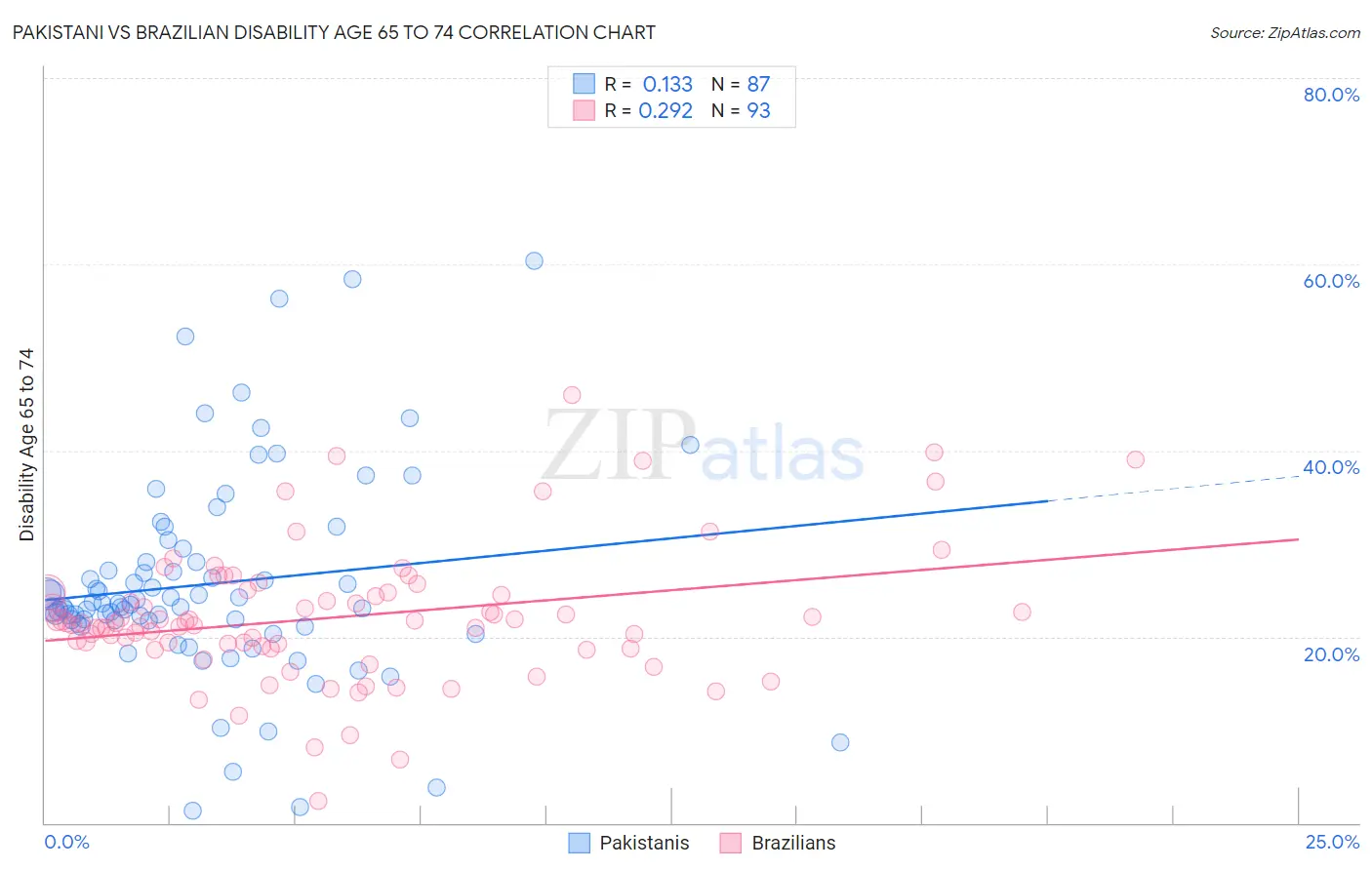Pakistani vs Brazilian Disability Age 65 to 74
COMPARE
Pakistani
Brazilian
Disability Age 65 to 74
Disability Age 65 to 74 Comparison
Pakistanis
Brazilians
23.2%
DISABILITY AGE 65 TO 74
57.0/ 100
METRIC RATING
168th/ 347
METRIC RANK
22.4%
DISABILITY AGE 65 TO 74
94.8/ 100
METRIC RATING
116th/ 347
METRIC RANK
Pakistani vs Brazilian Disability Age 65 to 74 Correlation Chart
The statistical analysis conducted on geographies consisting of 334,780,932 people shows a poor positive correlation between the proportion of Pakistanis and percentage of population with a disability between the ages 65 and 75 in the United States with a correlation coefficient (R) of 0.133 and weighted average of 23.2%. Similarly, the statistical analysis conducted on geographies consisting of 323,321,623 people shows a weak positive correlation between the proportion of Brazilians and percentage of population with a disability between the ages 65 and 75 in the United States with a correlation coefficient (R) of 0.292 and weighted average of 22.4%, a difference of 4.0%.

Disability Age 65 to 74 Correlation Summary
| Measurement | Pakistani | Brazilian |
| Minimum | 1.3% | 2.4% |
| Maximum | 60.4% | 45.9% |
| Range | 59.1% | 43.6% |
| Mean | 25.7% | 22.1% |
| Median | 23.4% | 21.5% |
| Interquartile 25% (IQ1) | 21.4% | 18.9% |
| Interquartile 75% (IQ3) | 28.1% | 24.8% |
| Interquartile Range (IQR) | 6.7% | 5.8% |
| Standard Deviation (Sample) | 11.0% | 7.2% |
| Standard Deviation (Population) | 11.0% | 7.1% |
Similar Demographics by Disability Age 65 to 74
Demographics Similar to Pakistanis by Disability Age 65 to 74
In terms of disability age 65 to 74, the demographic groups most similar to Pakistanis are Immigrants from Bosnia and Herzegovina (23.2%, a difference of 0.040%), Icelander (23.3%, a difference of 0.16%), Moroccan (23.3%, a difference of 0.16%), Immigrants from Afghanistan (23.2%, a difference of 0.22%), and Vietnamese (23.2%, a difference of 0.23%).
| Demographics | Rating | Rank | Disability Age 65 to 74 |
| Immigrants | Cameroon | 63.8 /100 | #161 | Good 23.1% |
| Europeans | 61.2 /100 | #162 | Good 23.2% |
| Immigrants | Philippines | 61.1 /100 | #163 | Good 23.2% |
| Sierra Leoneans | 60.9 /100 | #164 | Good 23.2% |
| Vietnamese | 60.8 /100 | #165 | Good 23.2% |
| Immigrants | Afghanistan | 60.5 /100 | #166 | Good 23.2% |
| Immigrants | Bosnia and Herzegovina | 57.6 /100 | #167 | Average 23.2% |
| Pakistanis | 57.0 /100 | #168 | Average 23.2% |
| Icelanders | 54.3 /100 | #169 | Average 23.3% |
| Moroccans | 54.2 /100 | #170 | Average 23.3% |
| Cubans | 51.9 /100 | #171 | Average 23.3% |
| Germans | 50.5 /100 | #172 | Average 23.3% |
| Yugoslavians | 50.2 /100 | #173 | Average 23.3% |
| Immigrants | South Eastern Asia | 50.0 /100 | #174 | Average 23.3% |
| Dutch | 49.4 /100 | #175 | Average 23.3% |
Demographics Similar to Brazilians by Disability Age 65 to 74
In terms of disability age 65 to 74, the demographic groups most similar to Brazilians are Swedish (22.4%, a difference of 0.010%), Austrian (22.4%, a difference of 0.020%), Immigrants from Northern Africa (22.4%, a difference of 0.020%), Laotian (22.3%, a difference of 0.040%), and Ukrainian (22.3%, a difference of 0.10%).
| Demographics | Rating | Rank | Disability Age 65 to 74 |
| Albanians | 95.8 /100 | #109 | Exceptional 22.3% |
| Immigrants | Peru | 95.7 /100 | #110 | Exceptional 22.3% |
| Serbians | 95.7 /100 | #111 | Exceptional 22.3% |
| Immigrants | South America | 95.5 /100 | #112 | Exceptional 22.3% |
| Syrians | 95.3 /100 | #113 | Exceptional 22.3% |
| Ukrainians | 95.1 /100 | #114 | Exceptional 22.3% |
| Laotians | 94.9 /100 | #115 | Exceptional 22.3% |
| Brazilians | 94.8 /100 | #116 | Exceptional 22.4% |
| Swedes | 94.7 /100 | #117 | Exceptional 22.4% |
| Austrians | 94.7 /100 | #118 | Exceptional 22.4% |
| Immigrants | Northern Africa | 94.7 /100 | #119 | Exceptional 22.4% |
| Immigrants | Kazakhstan | 93.9 /100 | #120 | Exceptional 22.4% |
| Czechs | 93.5 /100 | #121 | Exceptional 22.4% |
| Immigrants | Jordan | 93.5 /100 | #122 | Exceptional 22.4% |
| Hungarians | 93.3 /100 | #123 | Exceptional 22.4% |